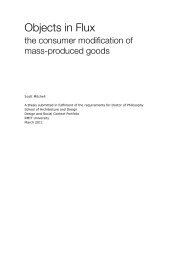Making Memory Space: Recollection and Reconciliation in Post ...
Making Memory Space: Recollection and Reconciliation in Post ...
Making Memory Space: Recollection and Reconciliation in Post ...
Create successful ePaper yourself
Turn your PDF publications into a flip-book with our unique Google optimized e-Paper software.
Museums <strong>and</strong> memorials, as physical embodiments of collective memory, <strong>and</strong> representatives of civic<br />
<strong>in</strong>stitutions are surely culpable <strong>in</strong> the establishment <strong>and</strong> ma<strong>in</strong>tenance of specific memory narratives.<br />
By mak<strong>in</strong>g tangible the <strong>in</strong>tangible <strong>and</strong> provid<strong>in</strong>g physical form to the nebulous past, memory space<br />
proffers a solid perspective on the past, one that cannot be readily eradicated. 25<br />
Yet, the mercurial nature of memory calls <strong>in</strong>to question the reliability of history which is often<br />
presented as a def<strong>in</strong>itive version of the past. Many theorists have contended with the differ<strong>in</strong>g notions<br />
of memory <strong>and</strong> history. Pierre Nora def<strong>in</strong>es memory as exist<strong>in</strong>g <strong>in</strong> an ongo<strong>in</strong>g state of change,<br />
vulnerable to remember<strong>in</strong>g <strong>and</strong> forgett<strong>in</strong>g <strong>and</strong> history as a sanctioned representation of the past, a<br />
discourse, which distrusts the fluidity of memory. He asserts that a form of constructed history has<br />
replaced actual recollection. Nora posits a dual concept of ‘lieux de mémoire’ where<strong>in</strong> a sense of the<br />
past is constructed from a specific entity <strong>and</strong> the ‘milieux de mémoire’, where<strong>in</strong> the past emerges from<br />
lived history <strong>and</strong> social practice. 26 Jonathan Crewe highlights the need to dist<strong>in</strong>guish between cultural<br />
memory <strong>and</strong> history, suggest<strong>in</strong>g that one is often substituted for the other over time result<strong>in</strong>g <strong>in</strong> a<br />
murky <strong>in</strong>terchange that allows for the corruption of memory or authoritative historical narratives. 27<br />
Dist<strong>in</strong>ctions between memory <strong>and</strong> history become <strong>in</strong>creas<strong>in</strong>gly difficult to determ<strong>in</strong>e because of the<br />
resemblance, overlapp<strong>in</strong>g <strong>and</strong> <strong>in</strong>tersection between the two. History <strong>and</strong> memory are considered to be<br />
mutually exclusive when <strong>in</strong> fact, the production of one often <strong>in</strong>forms the other. Architecture contributes<br />
to this dissolution through the authoritative nature of built form that often adds to a specific vision of<br />
the world, or a set of values, but does so discretely. <strong>Memory</strong> space is <strong>in</strong>tended to allow for<br />
recollection, but the concretised architectural form often presents an authoritative perspective on the<br />
past.<br />
In countries or situations where memory of the past is still active <strong>in</strong> the present, the character <strong>and</strong> form<br />
of the memory often contribute to revised visions of self. The notion that this recollection can be<br />
<strong>in</strong>fluenced or modelled accord<strong>in</strong>g to political aims or social desires reveals the power <strong>in</strong>herent <strong>in</strong><br />
concepts of memory. Such ideas form the basis for the social construction of memory as def<strong>in</strong>ed by<br />
Eric Hobsbawm <strong>and</strong> Terrance Ranger, who suggest that politics manipulates the past to <strong>in</strong>vent<br />
traditions that serve its <strong>in</strong>terest. 28 They argue that the past becomes a vehicle to v<strong>in</strong>dicate actions of<br />
the present or future. This is shown to be evident <strong>in</strong> recent examples, such as the attacks on the Tw<strong>in</strong><br />
Towers of Manhattan. The result<strong>in</strong>g political events illustrate the extent to which collective memory<br />
can be utilised to facilitate political aims <strong>and</strong> to justify action based on a shared sense of the past. In<br />
some ways this recollection becomes a m<strong>and</strong>ate for revis<strong>in</strong>g the status quo, the result of which can<br />
25 The notion that memory space is immutable <strong>and</strong> therefore uncontestable is a contentious one, that is discussed at some<br />
length through the course of this writ<strong>in</strong>g. It may also be argued that precisely because of its very materiality <strong>and</strong> physicality<br />
monuments are accessible <strong>and</strong> open to challenge <strong>and</strong> discussion. This is not without complexity <strong>and</strong> is discussed <strong>in</strong> the<br />
follow<strong>in</strong>g chapter.<br />
26 Pierre Nora, Realms of <strong>Memory</strong> (New York: Columbia University Press, 1998).<br />
27 Jonathan Crewe, ‘Recall<strong>in</strong>g Adamastor: Literature as Cultural <strong>Memory</strong> <strong>in</strong> “white” South Africa’, <strong>in</strong> Mieke Bal, Jonathan Crewe,<br />
<strong>and</strong> Leo Spitzer (eds.), Acts of <strong>Memory</strong>: Cultural Recall <strong>in</strong> the Present (Hanover <strong>and</strong> London: University Press of New Engl<strong>and</strong>,<br />
1999), p.76.<br />
28 Eric Hobsbawm <strong>and</strong> Terrance Ranger (eds.), The Invention of Tradition (Cambridge: Cambridge University Press, 1983).<br />
16
















